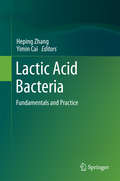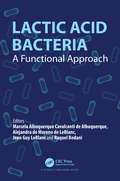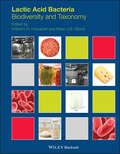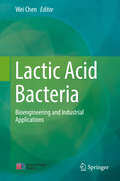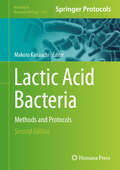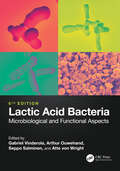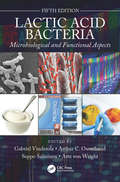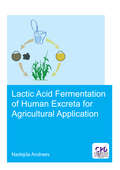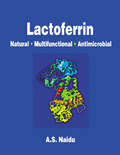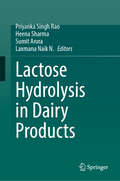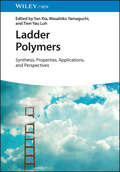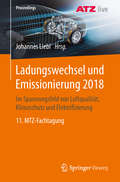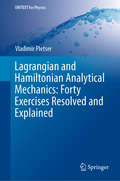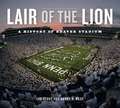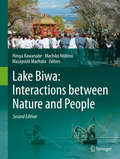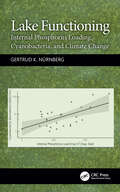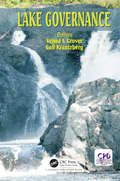- Table View
- List View
Lactic Acid Bacteria
by Heping Zhang Yimin CaiThe book summarizes the latest research and developments in dairy biotechnology and engineering. It provides a strategic approach for readers relating to fundamental research and practical work with lactic acid bacteria. The book covers every aspect from identification, ecology, taxonomy and industrial use. All contributors are experts who have substantial experience in the corresponding research field. The book is intended for researchers in the human, animal, and food sciences related to lactic acid bacteria. Dr. Heping Zhang is a Professor at the Key Laboratory of Dairy Biotechnology and Engineering Ministry of Education, Inner Mongolia Agricultural University, China. Dr. Yimin Cai works in Livestock and Environment Division, Japan International Research Center for Agricultural Sciences (JIRCAS), Japan.
Lactic Acid Bacteria in Foodborne Hazards Reduction: Physiology to Practice
by Wei Chen Arjan NarbadThis book provides an overview of the physiological basis of lactic acid bacteria and their applications in minimizing foodborne risks, such as pathogens, heavy metal pollution, biotoxin contamination and food‐based allergies. While highlighting the mechanisms responsible for these biological effects, it also addresses the challenges and opportunities that lactic acid bacteria represent in food safety management. It offers a valuable resource for researchers, graduate students, nutritionists and product developers in the fields of food science and microbiology.
Lactic Acid Bacteria: A Functional Approach
by Alejandra de Moreno de LeBlancLactic acid bacteria (LAB) are a diverse group of bacteria that comprise low GC content Gram-positive cocci or rods that produces lactic acid as the major end product of the fermentation process. Bifidobacterium genera may also be considered as a part of the LAB group for possessing some similar phenotypical characteristics despite the higher GC content. The key feature of LAB metabolism is efficient carbohydrate fermentation. This contributes to the production of several microbial metabolites that result in the improvement of flavor and texture of fermented foods, in addition to its positive impact on the human health when LAB is administered as a probiotic. The book deals with advances made in the functionalities of LAB, such as their effect on vitamin D receptor expression, impact on neurodegenerative pathologies, production of B-vitamins for food bio-enrichment, production of bacteriocins to improve gut microbiota dysbiosis, production of metabolites from polyphenols and their effects on human health, effect on reducing the immunoreaction of food allergens, as biological system using time-temperature to improve food safety, and the use of probiotics in animal feed. The book also reviews the use of LAB and probiotic technologies to develop new functional foods and functional pharmaceuticals.
Lactic Acid Bacteria: Biodiversity and Taxonomy (The\lactic Acid Bacteria Ser. #3)
by Brian J.B. Wood Wilhelm H. HolzapfelThe lactic acid bacteria (LAB) are a group of related micro-organisms that are enormously important in the food and beverage industries. Generally regarded as safe for human consumption (and, in the case of probiotics, positively beneficial to human health), the LAB have been used for centuries, and continue to be used worldwide on an industrial scale, in food fermentation processes, including yoghurt, cheeses, fermented meats and vegetables, where they ferment carbohydrates in the foods, producing lactic acid and creating an environment unsuitable for food spoilage organisms and pathogens to survive. The shelf life of the product is thereby extended, but of course these foods are also enjoyed around the world for their organoleptic qualities. They are also important to the brewing and winemaking industries, where they are often undesirable intruders but can in specific cases have desirable benefits. The LAB are also used in producing silage and other agricultural animal feeds. Clinically, they can improve the digestive health of young animals, and also have human medical applications. This book provides a much-needed and comprehensive account of the current knowledge of the lactic acid bacteria, covering the taxonomy and relevant biochemistry, physiology and molecular biology of these scientifically and commercially important micro-organisms. It is directed to bringing together the current understanding concerning the organisms’ remarkable diversity within a seemingly rather constrained compass. The genera now identified as proper members of the LAB are treated in dedicated chapters, and the species properly recognized as members of each genus are listed with detailed descriptions of their principal characteristics. Each genus and species is described using a standardized format, and the relative importance of each species in food, agricultural and medical applications is assessed. In addition, certain other bacterial groups (such as Bifidobacterium) often associated with the LAB are given in-depth coverage. The book will also contribute to a better understanding and appreciation of the role of LAB in the various ecological ecosystems and niches that they occupy. In summary, this volume gathers together information designed to enable the organisms’ fullest industrial, nutritional and medical applications. Lactic Acid Bacteria: Biodiversity and Taxonomy is an essential reference for research scientists, biochemists and microbiologists working in the food and fermentation industries and in research institutions. Advanced students of food science and technology will also find it an indispensable guide to the subject.
Lactic Acid Bacteria: Bioengineering and Industrial Applications
by Wei ChenThis book introduces readers to basic studies on and applied techniques involving lactic acid bacteria, including their bioengineering and industrial applications. It summarizes recent biotechnological advances in lactic acid bacteria for food and health, and provides detailed information on the applications of these bacteria in fermented foods. Accordingly, it offers a valuable resource for researchers and graduate students in the fields of food microbiology, bioengineering, fermentation engineering, food science, nutrition and health.
Lactic Acid Bacteria: Methods and Protocols (Methods in Molecular Biology #2851)
by Makoto KanauchiThis updated volume presents experimentation-based approaches to lactic acid bacteria (LAB) research. Split into three parts, the book explores techniques for analyzing lactic acid bacteria metabolism and characteristics, applications for food-related industries, such as yogurt production, beer, and wine making, and functions of LAB in human health. Written for the highly successful Methods in Molecular Biology series, chapters include introduction to their respective topic, lists of the necessary materials and reagents, step-by-step and readily reproducible laboratory protocols, and tips on troubleshooting and avoiding known pitfalls. Authoritative and up-to-date, Lactic Acid Bacteria: Methods and Protocols, Second Edition serves as an ideal guide for improving research into this vital area of nutrition and health science.
Lactic Acid Bacteria: Microbiological and Functional Aspects
by Seppo Salminen Atte Von Wright Gabriel Vinderola Arthur C. OuwehandThrough five editions, and since 1993, Lactic Acid Bacteria: Microbiological and Functional Aspects has provided readers with information on how and why fermentation by lactic acid-producing bacteria improves the shelf life, palatability, and nutritive value of perishable foods and also how these microbes have been used as probiotics for decades. Thoroughly updated (with the current lactobacilli taxonomy) and fully revised, with a rearrangement of chapters into four sections, the Sixth Edition covers new findings on health effects, properties, production and stability of LAB as well as regulatory aspects globally. The new edition also addresses the technological use of LAB in various fermentations of food, feed, and beverage and their safety considerations. It also includes the rising concept of postbiotics and discusses new targets such as cognitive function, metabolic health, and respiratory health.Key Features: In 42 chapters, divided into 4 sections, findings are presented on health effects, properties and stability of LAB as well as production of target-specific LAB. Covers the revised ‘Lactobacillus’ taxonomy Addresses novel topics such as postbiotics Presents new discoveries related to the mechanisms of actions of lactic acid bacteria Covers the benefits of LAB in fermentation of dairy, cereal, meat, vegetable and silage, including non-Western traditional fermented foods from Africa and Asia Discusses the less-known role of LAB as food spoilers Reports on the health benefits of LAB on humans and animals Covers the global regulatory framework related to safety and efficacy
Lactic Acid Bacteria: Microbiological and Functional Aspects, Fifth Edition
by Seppo Salminen Atte Von Wright Gabriel Vinderola Arthur OuwehandThrough four editions, Lactic Acid Bacteria: Microbiological and Functional Aspects, has provided readers with information on the how’s and why’s lactic acid-producing fermentation improves the storability, palatability, and nutritive value of perishable foods. Thoroughly updated and fully revised, with 12 new chapters, the Fifth Edition covers regulatory aspects globally, new findings on health effects, properties and stability of LAB as well as production of target specific LAB. The new edition also addresses the technological use of LAB in various fermentations of food, feed and beverage, and their safety considerations. It features the detailed description of the main genera of LAB as well as such novel bacteria as fructophilic LAB and novel probiotics and discusses such new targets as cognitive function, metabolic health, respiratory health and probiotics. Key Features: In 12 new chapters, findings are presented on health effects, properties and stability of LAB as well as production of target specific LAB Covers such novel bacteria as fructophilic LAB and novel probiotics Presents new discoveries related to the mechanisms of lactic acid bacterial metabolism and function Covers the benefits of LAB, both in fermentation of dairy, cereal, meat, vegetable and silage, and their health benefits on humans and animals Discusses the less-known role of LAB as food spoilers Covers the global regulatory framework related to safety and efficacy
Lactic Acid Bacteria: Omics and Functional Evaluation
by Wei ChenThis book discusses the latest research and new techniques in the field of lactic acid bacteria, including comparative genomics, transcriptomics, proteomics and metabolomics. It also introduces the omics and functional evaluation in detail and shows the links between lactic acid bacteria and gut health and host immunity. Summarizing the biotechnological advances in lactic acid bacteria for food and health, it is a valuable resource for researchers and graduate students in the fields of food microbiology, bioengineering, food science, nutrition and health.
Lactic Acid Fermentation of Fruits and Vegetables (Food Biology Series)
by Spiros ParamithiotisLactic acid fermentation has been practiced for thousands of years mainly to preserve surplus and perishable foodstuff and also to enhance them organoleptically. Lactic acid fermentation of fruits and vegetables is no exception, leading to the production of a wide range of products, some of which are now considered as characteristic of certain geographical areas and cultures. The aim of this book is to collect, present, and discuss all available information regarding lactic acid fermentation of fruits and vegetables. For this purpose, an international group of experts was invited to contribute their knowledge and experience in a highly informative and comprehensive way. The book consists of fourteen chapters. The first five chapters integrate aspects that apply to all products. Then, chapters 6 to 9 are dedicated to products that have met commercial significance and have been extensively studied, i.e. sauerkraut, kimchi, fermented cucumbers and olives. In chapters 10 to 13, regional products with great potential from Asia, Europe and Africa, as well as lactic acid fermented juices and smoothies, are presented and thoroughly discussed. Finally, chapter 14 discusses the fields in which intensive study is expected to take place in the coming years.
Lactic acid fermentation of human excreta for agricultural application (IHE Delft PhD Thesis Series)
by Nadejda AndreevHuman excreta is a valuable fertilizer for improving soil quality and crop productivity, with a potential to replace or complement the mineral fertilizers. The main challenges related to human excreta regarding agricultural applications are microbial contamination risks, loss of nutrients, and odor issues. Fertilization by lacto-fermented faeces supplemented by biochar has benefits such as improved soil bulk density, nitrate and potassium concentrations as well as the yield and yield components of corn, compared to untreated, simple stored faeces, urine, cattle manure, and unfertilized controls. Even though the mineral fertilizer produced corn with significantly higher height and leaf length, it did not add significantly higher yields than lacto-fermented faeces supplemented by biochar. A faeces treatment process by combined lacto-fermentation with thermophilic composting and biochar supplementation had better reduction of coliforms, Escherichia coli, Enterococcus faecalis and Clostridium perfringens, and higher germination of radish and growth of tomatoes than combined lacto-fermentation with vermicomposting. Urine lacto-fermentation contributed to a pH reduction below 4, a decrease in the ammonium concentration and odor strength, as well as an increase in the germination rates compared to untreated stored urine. The results of this study provide important information that can set the basis for scaling up a sustainable technology for the treatment of source separated human excreta while improving its potential for resource recovery.
Lactoferrin: Natural - Multifunctional - Antimicrobial
by Narian NaiduRecently, researchers found that lactoferrin, when activated, functions as a potent antimicrobial intervention. It protects food by removing harmful bacteria from the surface and by starving bacteria before they can multiply and produce harmful toxins; it also prevents bacteria from re-attaching to food surfaces. As a result this substance has potential to help the agribusiness and food industry supply safer food products to consumers. Lactoferrin: Natural - Multifunctional - Antimicrobial details microbial blocking technology to protect foods from harmful microbes and presents the scientific background on use of this naturally occurring microbial blocking agent as an effective food antimicrobial intervention.
Lactose Hydrolysis in Dairy Products
by Priyanka Singh Rao Heena Sharma Sumit Arora Laxmana Naik N.Lactose is the major disaccharide present in milk. Metabolism of lactose requires lactase which is present in the brush border of epithelial cells of the small intestine. Deficiency of this enzyme leads to malabsorption of lactose and fermentation of lactose occurs in gut which results in various gastrointestinal disorders. Around 70% of the world population suffers from lactose intolerance. Such individuals face difficulty in consumption of milk and milk products. This has led to a great demand in market for the milk products which are either low in lactose or lactose free. Major advances have been made in the production of lactose-free dairy products through lactose hydrolysis processing methods. Most of the books available on lactose hydrolysis in dairy products were published from 1970-1990. Awareness on lactose intolerance has increased in past one decade and development of new strategies to address this issue are progressing at rapid rate. There is a great need for consolidated information representing all aspects of lactose hydrolyzed dairy products. Lactose Hydrolysis in Dairy Products addresses the significance and application of lactose hydrolyzed products from production to consumption. It mainly emphasizes the basic principles that are essential to understand the concept of lactose intolerance and the various processes utilized for production of lactose-free dairy foods. Methods such as enzymatic hydrolysis, membrane processing and fermentation are covered in full. Further coverage includes alternative approaches to combat lactose intolerance, conversion of lactose to other bioactive derivatives and their health effects and the regulatory aspects and the main challenges and potential solutions for the production of lactose hydrolyzed products.
Ladder Polymers: Synthesis, Properties, Applications and Perspectives
by Yan Xia Masahiko Yamaguchi Tien-Yau LuhLadder Polymers An essential reference covering the latest research on ladder polymers Ladder polymers are a unique macromolecular architecture, consisting of a continuous strand of fused rings in their backbones. Such distinctive structures lead to a range of interesting thermal, optical, and electronic properties and self-assembly behaviors, which have been explored for various applications. The book Ladder Polymers: Synthesis, Properties, Applications, and Perspectives presents a collection of diverse topics in ladder polymers consisting of historical overview, state-of-the-art research and development, and potential future directions, written by leading researchers in the related fields. The topics include: Conjugated ladder polymers and graphene nanoribbons Nonconjugated microporous ladder polymers or polymers of intrinsic microporosity Covalent double-stranded polymersSupramolecular double-helical polymers and oligomers Two dimensional polymers This book is a one-stop resource on all the critical research developments in the subject of ladder polymers for broad readership including organic, polymer, and physical chemists, materials scientists and engineers, and chemical engineers.
Ladungswechsel und Emissionierung 2018: Im Spannungsfeld von Luftqualität, Klimaschutz und Elektrifizierung 11. MTZ-Fachtagung (Proceedings)
by Johannes LieblDie inhaltlichen Schwerpunkte des Tagungsbands zur ATZlive-Veranstaltung Ladungswechsel und Emissionierung 2018 sind unter anderem das Spannungsfeld von Luftqualität, Klimaschutz und Elektrifizierung. Die Tagung ist eine unverzichtbare Plattform für den Wissens- und Gedankenaustausch von Forschern und Entwicklern aller Unternehmen und Institutionen.
Lady's Knight
by Amie Kaufman Meagan SpoonerAn undeniably fierce, unforgettably funny, unapologetically queer feminist romp through the England of medieval legend. Bestselling and acclaimed authors Amie Kaufman and Meagan Spooner bring readers along on an epic quest for valor, freedom, and, above all, love. A Knight’s Tale meets the Lady Jane series, with a dash of The Great!Gwen is sick of hiding—hiding the fact that she’s taken over her father’s blacksmithing duties, hiding her attraction to girls, hiding her yearning for glory as a knight.Meanwhile, Lady Isobelle of Avington, queen bee of the castle, has never once considered hiding who she is—until now. She’s been chosen as the grand prize in the Tournament of Dragonslayers, to be given to whichever knight can claim her hand. And for the first time in her life, she can’t talk her way out of trouble.When Isobelle discovers Gwen’s knightly ambitions, they hatch a scheme together—Gwen will joust in the tournament, disguised as Sir Gawain. Winning means freedom for Isobelle, and glory for Gwen. Losing means… well, let’s not go there.One thing’s for sure: Falling in love was never the plan.But the best laid plans…are often trampled all over by dragons."A sapphic delight, full of jousts, jaunts, and courtly love. Lady's Knight sparkles with wit and charm and has lady knights to swoon over. Kaufman and Spooner will leave you breathless." —C. S. Pacat, New York Times bestselling author of Dark Rise“Kaufman and Spooner are auto-buy authors for me, always guaranteed to get my heart pumping with their page-turning romance and high-stakes adventure.” —New York Times bestselling author Susan Dennard"There are a lot of damsels in Lady's Knight, but none of them need a man to fix their problems. (Men seem to be the source of the problems, in fact.) Wholesome, heartfelt, and more fun than cheesecake on a stick, Kaufman and Spooner's latest book is all about women's work. You know, jousting, dragonslaying, and saving the kingdom—all while looking fabulous." —Jodi Meadows, coauthor of the New York Times bestselling novels My Lady Jane and My Plain Jane“Clever, funny, thrilling, and romantic—Lady’s Knight will inspire readers to take up their swords to fight dragons and the patriarchy. Perfect for fans of A Knight’s Tale and anyone who loves a romantasy with wit, charm, and the occasional comedic fourth wall break.” —F. T. Lukens, New York Times bestselling author of So This Is Ever After"You'll laugh, you'll cry, and you'll be ready to fight any dragon after reading this delightful tale full of swoony romance, heart-racing action, and the very best banter in the realm!" —Beth Revis, New York Times bestselling coauthor of Night of the Witch"Writing that is above all else marvelously warm and at the same time witty, adventure and romance that will sweep you off your feet—a double sweep, and a triumph!" —Sarah Rees Brennan, #1 Sunday Times bestselling author of Long Live Evil"Sparkles with wit and romance! So many quotable lines. Not to mention the sexiest gown-lacing scene in modern literature. Like its characters, Lady's Knight is endlessly clever and resourceful." —Ellen Kushner, award-winning author of Swordspoint
Lager im Bauwesen
by Helmut Eggert Tobias Block Wolfgang KauschkeBearing types and their scope of application are explained in detail and all problems connected with bearings are discussed. The revised new edition takes into account German and European standards. A handbook for design, detailing and construction.
Lagoa Santa Karst: Brazil's Iconic Karst Region (Cave and Karst Systems of the World)
by Augusto S. Auler Paulo PessoaThis book discusses the Lagoa Santa Karst, which has been internationally known since the pioneering studies of the Danish naturalist Peter Lund in the early 1800s. It covers the speleogenesis, geology, vegetation, fauna, hydrogeology, geomorphology, and anthropogenic use of the Lagoa Santa Karst and is the first English-language book on this major karst area. The area, which has been at the heart of the debate on the origin and age of human colonization in the Americas, is characterized by a classical and scenic karst landscape with limestone cliffs, karst lakes and karst plains, in addition to numerous solution dolines. More than 1,000 caves have been documented in the area, many with significant archeological and paleontological value. Despite its great importance, the Lagoa Santa Karst faces severe environmental threats due to limestone mining and the expansion of the metropolis of Belo Horizonte and its surrounding towns. The growing recognition of the area’s remarkable significance has led to increasing concern, and a number of protected areas have now been established, improving the conservation status of this landmark karst area.
Lagrangian and Hamiltonian Analytical Mechanics: Forty Exercises Resolved and Explained (UNITEXT for Physics)
by Vladimir PletserThis textbook introduces readers to the detailed and methodical resolution of classical and more recent problems in analytical mechanics. This valuable learning tool includes worked examples and 40 exercises with step-by-step solutions, carefully chosen for their importance in classical, celestial and quantum mechanics. The collection comprises six chapters, offering essential exercises on: (1) Lagrange Equations; (2) Hamilton Equations; (3) the First Integral and Variational Principle; (4) Canonical Transformations; (5) Hamilton – Jacobi Equations; and (6) Phase Integral and Angular FrequenciesEach chapter begins with a brief theoretical review before presenting the clearly solved exercises. The last two chapters are of particular interest, because of the importance and flexibility of the Hamilton-Jacobi method in solving many mechanical problems in classical mechanics, as well as quantum and celestial mechanics.Above all, the book provides students and teachers alike with detailed, point-by-point and step-by-step solutions of exercises in Lagrangian and Hamiltonian mechanics, which are central to most problems in classical physics, astronomy, celestial mechanics and quantum physics.
Lair of the Lion: A History of Beaver Stadium (Keystone Books)
by Lee Stout Harry H. WestFootball is an unmistakable part of the culture of Penn State, though the experience of a Nittany Lions home game—from the crowds and tailgates to the spectacle of the game itself—has changed significantly over the years. This richly illustrated and researched book tells the story of the structure that has evolved along with the university’s celebrated football program: the iconic Beaver Stadium.Historian Lee Stout and engineering professor Harry H. West show how Beaver Stadium came to be, including a look at its predecessors, “Old” Beaver Field, built in 1893 on a site centrally located northeast of Old Main, and “New” Beaver Field, built on the northwest corner of campus in 1909. Stout and West explore the engineering and construction challenges of the stadium and athletic fields and reveal the importance of these facilities to the history of Penn State and its cherished traditions. Packed with archival photos and fascinating stories, Lair of the Lion is a celebration of the ways in which Penn State fans, students, and athletes have experienced home games from the 1880s to the present day, and of the monumental structure that the Lions now call home.
Lair of the Lion: A History of Beaver Stadium (Keystone Books)
by Lee Stout Harry H. WestFootball is an unmistakable part of the culture of Penn State, though the experience of a Nittany Lions home game—from the crowds and tailgates to the spectacle of the game itself—has changed significantly over the years. This richly illustrated and researched book tells the story of the structure that has evolved along with the university’s celebrated football program: the iconic Beaver Stadium.Historian Lee Stout and engineering professor Harry H. West show how Beaver Stadium came to be, including a look at its predecessors, “Old” Beaver Field, built in 1893 on a site centrally located northeast of Old Main, and “New” Beaver Field, built on the northwest corner of campus in 1909. Stout and West explore the engineering and construction challenges of the stadium and athletic fields and reveal the importance of these facilities to the history of Penn State and its cherished traditions.Packed with archival photos and fascinating stories, Lair of the Lion is a celebration of the ways in which Penn State fans, students, and athletes have experienced home games from the 1880s to the present day, and of the monumental structure that the Lions now call home.
Lake Biwa: Interactions between Nature and People
by Hiroya Kawanabe Machiko Nishino Masayoshi MaehataThis book focuses on the long-term interactions between people and nature in and around Lake Biwa, one of the oldest lakes in the world. Accordingly, it not only covers the characteristics of the biota of this ancient lake, but also approaches it as a 'cultural ancient lake.' Furthermore, various problems affecting the lake, especially recent environmental changes that occurred before and after Japan's rapid economic growth of the 1950s and 60s, are reviewed, including water pollution, lakeshore development and the reclamation of attached lakes, alien and invasive species, and problems related to the recent warming of the climate. Lastly, by analyzing data on these problems collected by the local government and residents of the lake basin, the book provides a comprehensive outlook on the future of Lake Biwa and people's lifestyles. As such, it provides indispensable information for all people engaged in improving and conserving water regimes around the world, as well as people interested in the culture and history of Japan.
Lake Biwa: Second Edition
by Hiroya Kawanabe Machiko Nishino Masayoshi MaehataAlthough, the first edition had a similar focus, more than five years have passed since its publication and the biological and social circumstances of the lake have drastically changed due to, for example, the further expansion of alien species, the decrease of indigenous species, the progress of integrated watershed management by the Union of the Kansai Government which was established in 2010, the legislation of the Conservation and Restoration Act of Lake Biwa in 2015 and more. The new edition will therefore feature updated and new information on the above and more topics as well as updated and revised data based on the latest research. Inventories of respective taxa, especially those of small animals, are also revised based on the latest studies. Furthermore, this volume covers the characteristics of the biota of this ancient lake, but at the same time, it will also approach it as a ‘culture ancient lake’. Other topics also include water pollution, lakeshore development, the effects of global warming in the past and present, the influence of people, and countermeasures by local and national governments. Moreover, the volume also provides a comprehensive view on the future of Lake Biwa and that of its residents. Miraculously enough, this ancient lake has kept its water quality clear even until today despite the fact of more than 1.4 million people living on its shores. Finally, the book also gives indispensable information to those engaged in improving and conserving water regimes of lakes and other water bodies all over the world and to those interested in the culture and history of Japan. Lake Biwa is not only one of the rarest ancient lakes of the world, but the people’s involvement with the lake also goes back a long way. This is shown in the diverse culture developed in this area and in the various archaeological finds that date back as early as the Jomon Period, nearly 10.000 years ago. Today Lake Biwa fulfills an important role as a water resource by providing domestic, commercial, industrial, and agricultural water for over 14 million residents living around the Lake Biwa-Yodo River drainage basin. This updated volume focuses on the geological and biological features of the lake as well as on the long-term interactions between the people and the lake.
Lake Functioning: Internal Phosphorus Loading, Cyanobacteria, and Climate Change
by Gertrud K. NürnbergThis book explores the interconnections of internal phosphorus loading, cyanobacteria, and climate change and their role in determining water quality in freshwater. It goes on to discuss the sometimes elusive process of internal phosphorus loading with its chemical and biological roots. Reviewing recent observations on present and future climate change, the book explores its effects on lake functioning. It concludes with the abatement and prevention of cyanobacteria proliferation, including techniques that deal with internal phosphorus loading. Some key topics covered are: In-depth exploration of internal phosphorus loading and its quantification in global lakes with diverse morphometry, hydrology, geochemistry, and degree of eutrophication. Determination of climate change effects on physical, chemical, and cyanobacteria-related variables in tables based on more than 100 reviewed journal articles. Evidence for the enhancing influences of climate change on internal phosphorus load and cyanobacteria, and of internal load on cyanobacteria. This book will be of interest to limnologists, environmental and engineering professionals, and natural science students. It will also be an interesting read to government agents, lake managers, and others interested in maintaining lake water quality and understanding algal blooms.
Lake Governance: Lessons In Participatory Governance
by Velma I. Grover Gail KrantzbergThe Lake Governance book will focus on comparative analysis of governance structures by examining policy, legal and institutional structures of current transboundary commissions to develop a common framework for good governance of transboundary lakes. Cooperation among nations sharing natural resources is important for sustainable use of the shared resources. Lakes contribute a big part to GDP in most of the countries and in some cases are also responsible for providing fisheries (for food, source of protein and livelihood). Climate change and associated risks and uncertainties add more complexity to the problems. This book will explore current water governance challenges, knowledge gaps and recommend a framework for good lake governance.
